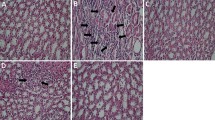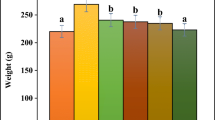Abstract
Thymus vulgaris (thyme) is commonly used in folk medicine for several therapeutic purposes. The aim of the present study was to evaluate the histopathological changes in the four vital organs, liver, kidney, heart, and brain, of diabetic and hyperlipidemic male rats after consumption of different doses of hydroalcoholic extract of thyme alone or in 11 combinations with atorvastatin. In a double-blind animal-based controlled randomized clinical trial, 90 male rats were randomly allocated into nine equal independent groups, according to consumption of atorvastatine and/or T. vulgaris extract, and the histopathological changes of vital organs of diabetic and hyperlipidemic male rats in response to T. vulgaris extract were evaluated. Our results indicated that in diabetes mellitus and hyperlipidemia, the liver and brain were observed to have more histopathological lesions than the kidney and heart. Also, after using atorvastatin, the frequency of brain histopathological lesions was decreased. In treatment groups, by increasing the dose of thyme extract, the hepatic histopathological lesions were disappeared and a decline in brain histopathological lesions was seen. It is found that atorvastatine can decrease the histopathological lesions especially in liver, if used alone or in combination with T. vulgaris extract.


Similar content being viewed by others
References
Amin KA, Abd El-Twab TM (2009) Oxidative markers, nitric oxide and homocysteine alteration in hypercholesterolimic rats: role of atorvastatine and cinnamon. Int J Clin Exp Med 2(3):254–265
Briones AM et al (2009) Atorvastatin prevents angiotensin II-induced vascular remodeling and oxidative stress. Hypertension 54:142–149
Brunetton J (1993) Pharmacognosie phytochimie plantes rnedicinales. Lavoisier
Cadirci E et al (2010) Atorvastatin reduces tissue damage in rat ovaries subjected to torsion and detorsion: biochemical and histopathologic evaluation. Naunyn-Schmied Arch Pharmacol 381:455–466
Ekoh SN, Akubugwo EI, Ude VC, Edwin N (2014) Anti-hyperglycemic and anti-hyperlipidemic effect of spices (Thymus vulgaris, Murraya koenigii, Ocimum gratissimum and Piper guineense) in alloxan-induced diabetic rats International. J Biosci 4:179–187
Elewa HF, Kozak A, El-Remessy AB, Frye RF, Johnson MH, Ergul A, Fagan SC (2009) Early atorvastatin reduces hemorrhage after acute cerebral ischemia in diabetic rats. J Pharmacol Exp Ther 330:532–540
Gottmann U et al (2007) Atorvastatin donor pretreatment prevents ischemia/reperfusion injury in renal transplantation in rats: possible role for aldose-reductase inhibition. Transplantation 84:755–762
Jukema JW, van der Hoorn JW (2004) Amlodipine and atorvastatin in atherosclerosis: a review of the potential of combination therapy. Expert Opin Pharmacother 5:459–468
Khodakaram Tafti A, Nazifi S, Rajaian H, Sepehrimanesh M, Poorbaghi SL, Mohtarami S (2008) Pathological changes associated with experimental salinomycin toxicosis in sheep. Comp Clin Pathol 17:255–258
Miura K, Kikuzaki H, Nakatani N (2002) 1845 − 1851. (2002) Antioxidant activity of chemical components from sage (Salvia officinalis L.) and thyme (Thymus vulgaris L.) measured by the oil stability index method. J Agric Food Chem 50:1845–1851
Numpaque MA, Oviedo LA, Gil JH, García CM, Durango DL (2011) Thymol and carvacrol: biotransformation and antifungal activity against the plant pathogenic fungi Colletotrichum acutatum and Botryodiplodia theobromae. Trop Plant Pathol 36:3–13
Rajaian H, Nazifi S, Mansourian M, Poorbaghi SL, Sepehrimanesh M, Ghezelbash A (2008) Pathological changes associated with experimental salinomycin toxicosis in calves. Online J Vet Res 12:15–22
Ramchoun M, Harnafi H, Alem C, Benlyas M, Elrhaffari L, Amrani S, Pharmacognosy Research 1 n (2009) Study on antioxidant and hypolipidemic effects of polyphenol-rich extracts from Thymus vulgaris and Lavendula multifida. Pharmacogn Res 1:106–112
Rashed K (2014) Medicinal plants with antioxidant potential: a review Hygeia. J Drugs Med 6:106–110
Rezatofighi SE, Seydabadi A, Seyyed Nejad SM (2014) Evaluating the efficacy of Achillea millefolium and Thymus vulgaris extracts against Newcastle disease virus in ovo Jundishapur. J Microbiol 7:e9016
Roby MHH, Sarhan MA, Selim KA, Khalel KI (2013) Evaluation of antioxidant activity, total phenols and phenolic compounds in thyme (Thymus vulgaris L.), sage (Salvia officinalis L.), and marjoram (Origanum majorana L.) extracts. Ind Crop Prod 43:827–831
Sepehrimanesh M, Azarpira N, Saeb M, Nazifi S, Kazemipour N, Koohi O (2014) Pathological changes associated with experimental 900-MHz electromagnetic wave exposure in rats. Comp Clin Pathol 23:1629–1631
Shan B, Cai YZ, Sun M, Corke H (2005) Antioxidant capacity of 26 spice extracts and characterization of their phenolic constituents. J Agric Food Chem 53:7749–7759
Tamadon A, Nikahval B, Sepehrimanesh M, Mansoorian M, Tabatabaii Naiini A, Nazifi S (2010) Epididymis ligation: a minimally invasive technique for preparation of teaser rams. Vet Surg 39:121–127
Vladimir-Knezevic S, Blazekovic B, Kindl M, Vladic J, Lower-Nedza AD, Brantner AH (2014) Acetylcholinesterase inhibitory, antioxidant and phytochemical properties of selected medicinal plants of the Lamiaceae family. Molecules 19:767–782
Wojdyło A, Oszmiański J, Czemerys R (2007) Antioxidant activity and phenolic compounds in 32 selected herbs. Food Chem 105:940–949
Zeghad N, Merghem R (2013) Antioxidant and antibacterial activities of Thymus vulgaris L. Med Aromat Plant Res J 1:5–11
Acknowledgments
We would especially like to thank Dr. Mahjoob Vahedi, the head of Animal Laboratory of Shiraz University of Medical Sciences, Shiraz, Iran, for providing the rats. The authors also would like to thank Gastroenterohepatology Research Center, Shiraz University of Medical Sciences for their financial supports.
Author information
Authors and Affiliations
Corresponding author
Rights and permissions
About this article
Cite this article
Koohi-Hosseinabadi, O., Moini, M., Safarpoor, A. et al. Effects of dietary Thymus vulgaris extract alone or with atorvastatin on the liver, kidney, heart, and brain histopathological features in diabetic and hyperlipidemic male rats. Comp Clin Pathol 24, 1311–1315 (2015). https://doi.org/10.1007/s00580-015-2070-7
Received:
Accepted:
Published:
Issue Date:
DOI: https://doi.org/10.1007/s00580-015-2070-7




